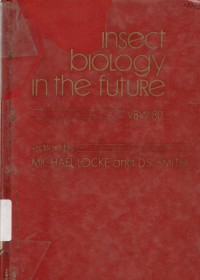
Text
Insect biology in the future "VBW 80"
Léon Dufour (1833) used the word for bug' in the strict entomological sense when he assured his readers that The gigantic baobab, the prodigious whale, the massive elephant, the proud human race, are not more valued by the Creator than the impalpable mussel... the earthworm and the bug.. each shows unnumbered marvels to the eye of the naturalist and all are appropriate subjects for our studies. Vhile it is difficult to fault Dufour on a point of principle, it is noteworthy that he eft whales and baobabs to others and shrewdly concentrated his efforts on the Hemiptera, and indeed probably knew more about the anatomy of these animals than anyone prior to Sir Vincent's picking up the functional challenge a century later. The contributions in this volume underline the value of insect material in ap- proaching a wide spectrum of biological questions. Practical problems attending less judicious selection are hinted at in Topsell's (1658) figure of the cetacean dis- section (1 ). By the early nineteenth century, a variety of insects had been examined with skill and scientific profit, and while Dufour did not, apparently, have access to Rhodnius prolixus (a reduviid that until Wigglesworth 's works was noted only as the vector of Chagas disease), he provided excellent figures of the anatomy of other Heteroptera, including that of the tracheal system of the water scorpion Nepa (2 ). Two figures from Wigglesworth's work (1940b) on Rhodnius (3 and 4 ) need no caption in the present context, but epitomize the experimental approach and inciden- tally emphasize to the mammalian physiologist and the surgeon the extremes of duress (the clinical term is "insult") that insects will survive in the interests of elucidation of basic physiological and developmental questions-and without the complications of tissue typing and rejection. We may even be reasonably sure that these radical operations were painless as discussed in the most recent work (Wigglesworth, 1980) that has come to our attention. Each of the authors in this volume has been, one way or another, beguiled by Insects. Some no doubt arrived via an often-reported empathy with these animals
Availability
| 13340 | 595.7 LOC i 13340 | Perpustakaan PPKS Medan Lt. 1 (Rak 595) | Available |
Detail Information
- Series Title
-
-
- Call Number
-
595.7 LOC i
- Publisher
- American : Acadeic press.,
- Collation
-
xiii, 963p.: ill.; - 21 cm.
- Language
-
English
- ISBN/ISSN
-
0-12-454340-5
- Classification
-
595.7
- Content Type
-
-
- Media Type
-
-
- Carrier Type
-
-
- Edition
-
-
- Subject(s)
- Specific Detail Info
-
-
- Statement of Responsibility
-
-
Other version/related
No other version available
File Attachment
Comments
You must be logged in to post a comment
 Computer Science, Information & General Works
Computer Science, Information & General Works  Philosophy & Psychology
Philosophy & Psychology  Religion
Religion  Social Sciences
Social Sciences  Language
Language  Pure Science
Pure Science  Applied Sciences
Applied Sciences  Art & Recreation
Art & Recreation  Literature
Literature  History & Geography
History & Geography